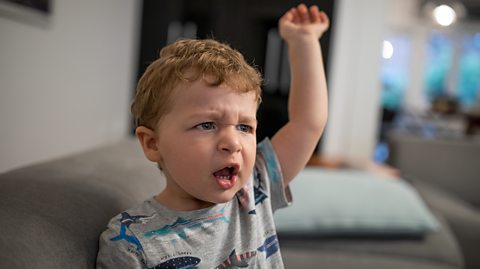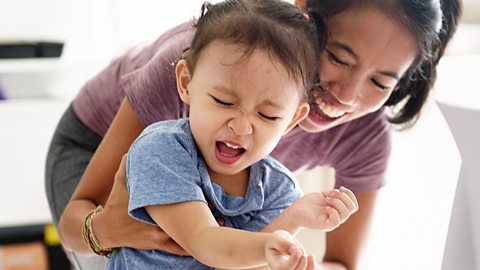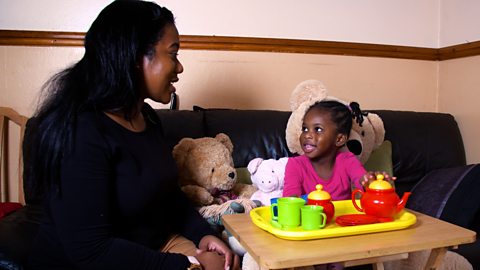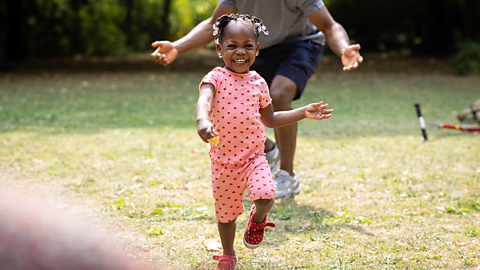You may have heard about the dreaded ŌĆśTerrible TwosŌĆÖ, from other parents or healthcare professionals. Or maybe youŌĆÖve experienced them or are experiencing them right now.
Well, we can reassure you that the Terrible Twos is a perfectly normal developmental phase that almost all children go through.
Just as Tiny Happy People reaches its 2nd birthday, we spoke to clinical psychologist Linda Blair to find out why the Terrible Twos happen and get her advice on how parents can cope with them.
What do the Terrible Twos look like?
If your child is going through this phase, chances are you know all too well what it looks like.
When children reach this stage, they will often have tantrums ranging from mild whining to wild frenzies. They may cry and scream and, in some circumstances, become physical - whether thatŌĆÖs kicking, hitting, or biting.
They may also experience mood swings and could suddenly become much more defiant. TheyŌĆÖre learning new skills, which give them the confidence to try and become more independent but often lack the ability to understand what theyŌĆÖre doing.

What causes the Terrible Twos?
ŌĆ£The problem is that the understanding your child has races ahead of their ability to express what they know,ŌĆØ says Linda, ŌĆ£and that's the reason they have these outbursts.ŌĆØ
The tantrums that children have when theyŌĆÖre toddlers are tied into their language development. The problem is that theyŌĆÖre unable to put into words what theyŌĆÖre feeling and what they need from the adults in their lives in order to help them cope with those emotions.
Your child is very frustrated when they have a tantrum because they may know what they want, but they are unable to express it.
When do the Terrible Twos start?
ŌĆ£Every childŌĆÖs brain is different, but usually it can start anywhere around 18 to 24 months,ŌĆØ says Linda. So for a lot of children, as the name suggests, the Terrible Twos starts as they approach their 2nd birthday. The reason for this is that around this age, the gap between what children understand and what they can express in words is so large.
Do all children go through the Terrible Twos?

According to Linda, just about every child goes through the Terrible Twos phase to some extent. However, some children will experience more tantrums than others. She explains that this comes down to differences in their developing personalities: ŌĆ£impulsive kids find it harder to wait, so if a child is always rushing into doing things and making a lot of mistakes because of their energy, they're more likely to have tantrums.ŌĆØ
When do the Terrible Twos end?
The tantrums that children experience tend to tail off as childrenŌĆÖs language skills begin to catch up with their brain development. This varies from child to child however, so donŌĆÖt expect them to magically snap out of it when they reach age 3.
ŌĆ£Most kids are pretty comfy with themselves and their ability to express themselves by around age 4,ŌĆØ says Linda, ŌĆ£but it's very rough. It could be 3-5 years of age.ŌĆØ
She emphasises that all children develop at different rates, but suggests that by the time children start school, their brains and language abilities are often well synced. ŌĆ£If you look all across the world, most schools start somewhere between four and seven, which is the crucial stage cognitively.ŌĆØ

How to deal with the Terrible Twos
Linda suggests that parents try and take comfort in the knowledge that tantrums will eventually pass.
Know, first of all, that it will end. Eventually their vocabulary will sync up with their understanding.
But what can you do to help your child through it and help you to keep your cool?
Look out for the warning signs
The first thing you can do as a parent is keep an eye on your childŌĆÖs behaviour and do your best to try and recognise what might be distressing them. ŌĆ£Some little kids get red in the face, some start pulling on their hair, some start making noises ŌĆō your first job is to be a detective and look for the different things that indicate their frustration is building.ŌĆØ
This involves a bit of guesswork on your part, as your child isnŌĆÖt necessarily able to tell you what the triggers are. But hopefully youŌĆÖll be able to meet their needs ŌĆō ŌĆ£they may be bored, tired or hungry, those are the most common reasons,ŌĆØ says Linda.

Keep talking to them
The key thing you can do to help speed up their journey out of this phase is to keep talking to your little one and helping to build their vocabulary. The quicker their language abilities catch up with their level of understanding, the quicker theyŌĆÖll be able to express their feelings and youŌĆÖll be able to meet their needs more quickly too.
The more you talk to them, the more will go in. Their brain is like a really rich compost waiting for the seeds, which you put in by talking to them as much as possible.
Try to be a good role model
Children learn most from you, so if you respond to frustration in an appropriate way, theyŌĆÖre more likely to learn to react appropriately in future too. ŌĆ£If youŌĆÖve overslept and missed your alarm clock and you react to that by having a tantrum yourself, I promise youŌĆÖre making tantrums more likely in your child,ŌĆØ says Linda. ŌĆ£But if, instead, you say calmly ŌĆśwell, that's gone wrong, I guess we're going to have to just turn up late and apologise,ŌĆÖ then your child will be soaking that up.ŌĆØ

Looking after yourself
Linda stresses that parents should not blame themselves for the tantrums that children have when theyŌĆÖre toddlers as thereŌĆÖs nothing they can do to avoid this natural developmental phase.
To help you cope with it though, she suggests reaching out to your support network. ŌĆ£Meet with a lot of other parents, that's a really good thing to do,ŌĆØ she emphasises. Not only will you pick up tips from other parents, but you may find reassurance in your shared problems: ŌĆ£youŌĆÖll get an idea of the failings other people have too!ŌĆØ
When to seek help
Tantrums are completely normal behaviour and to be expected in toddlers, however, you should seek help if youŌĆÖre at all concerned about your childŌĆÖs behaviour.
ŌĆ£If your child is harming themselves or others with their tantrums, or consistently damaging their possessions or surroundings, or if they are so frequent that you can't focus on either your work or others in the family, then you probably want to talk to your health visitor or GP,ŌĆØ says Linda.
The outside view of an experienced healthcare professional is important in these situations. ŌĆ£It's really hard to see it when you're in the middle of it as a parent because you look harder and harder and there's nothing to see,ŌĆØ Linda explains. On the other hand, your health visitor or GP may be able to identify whatŌĆÖs triggering your childŌĆÖs tantrums and help you meet their needs effectively or spot if there are any other underlying issues to address.
Further help with tantrums
For more advice, check out our film on dealing with toddler tantrums or our article on how to speak to children about their behaviour.






